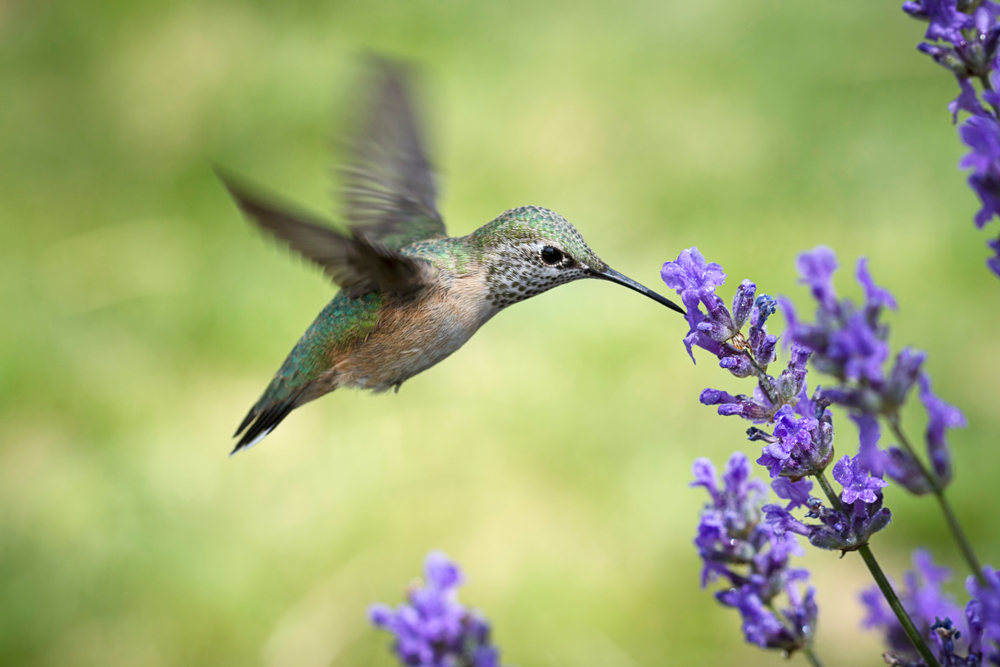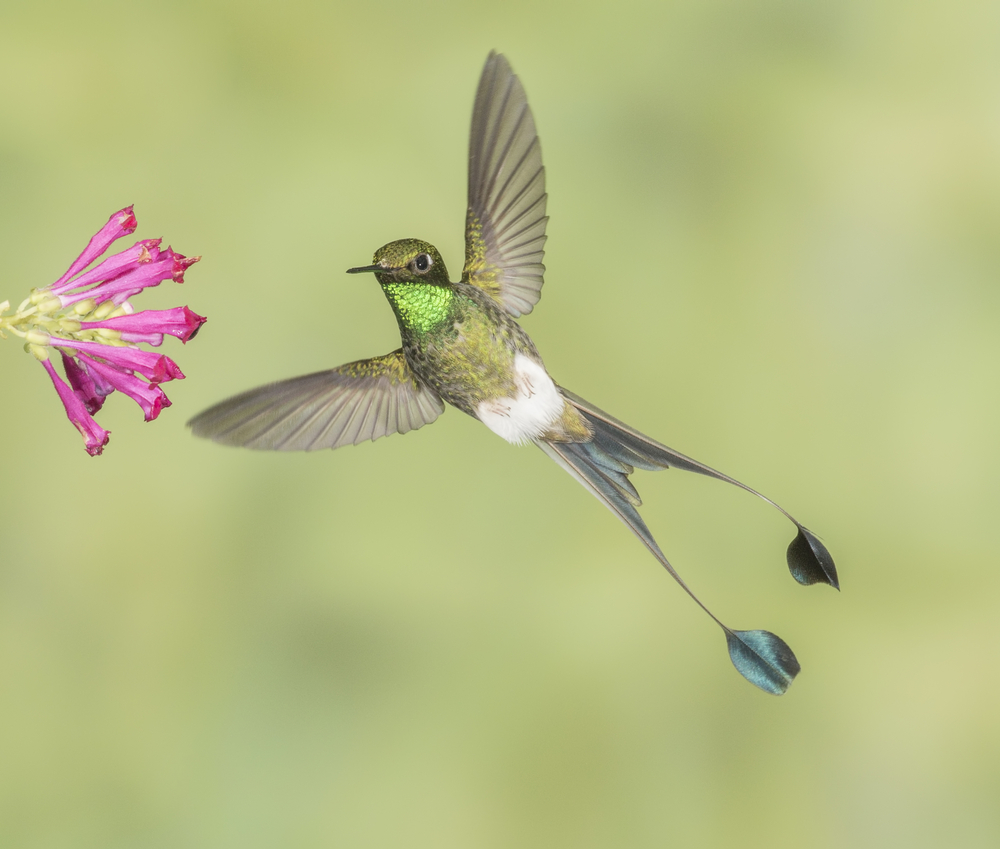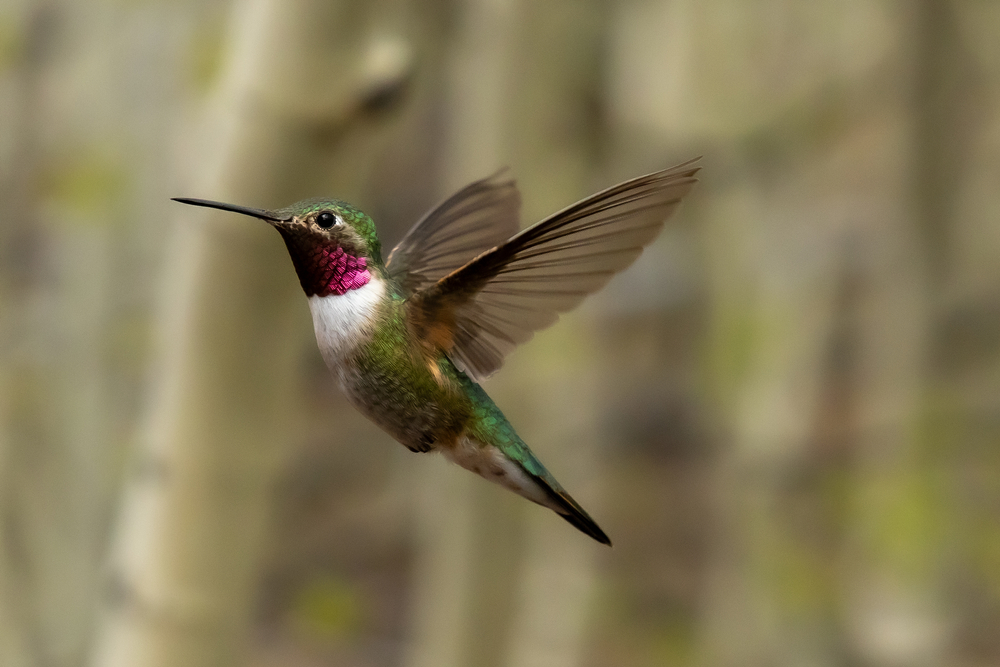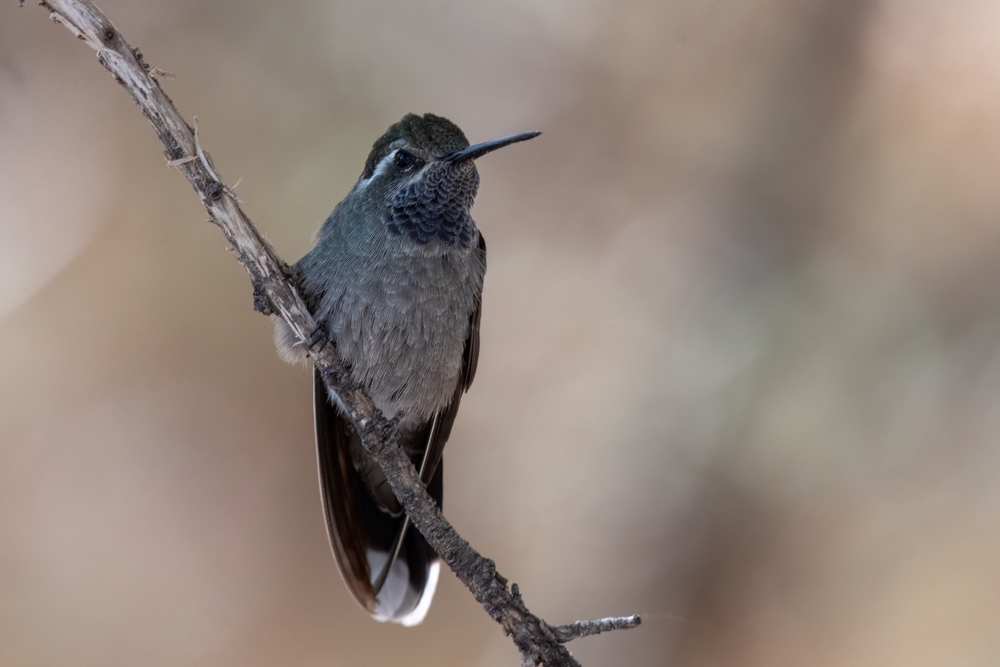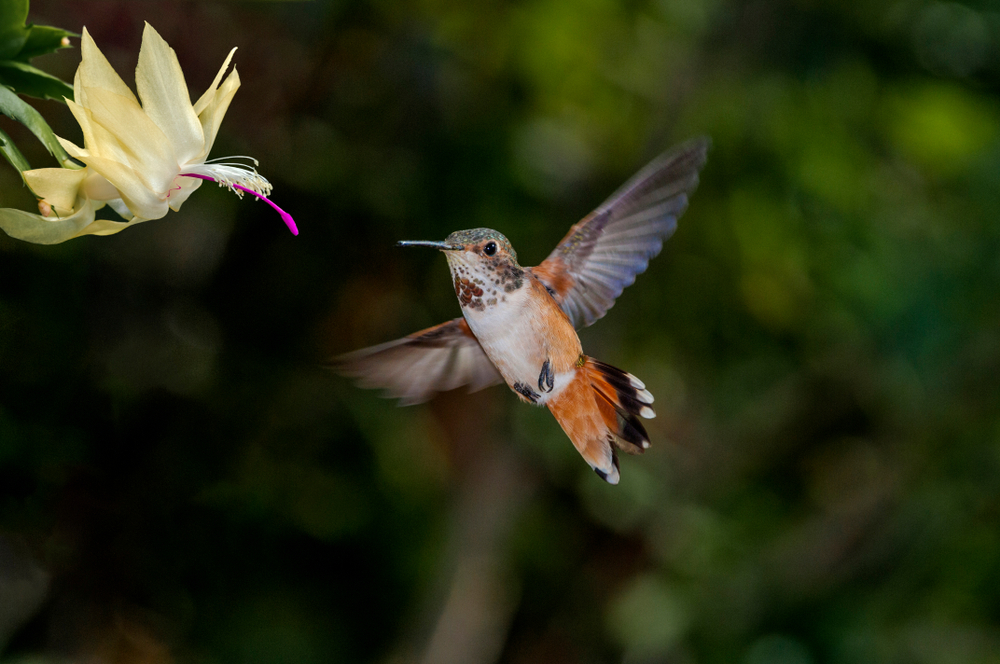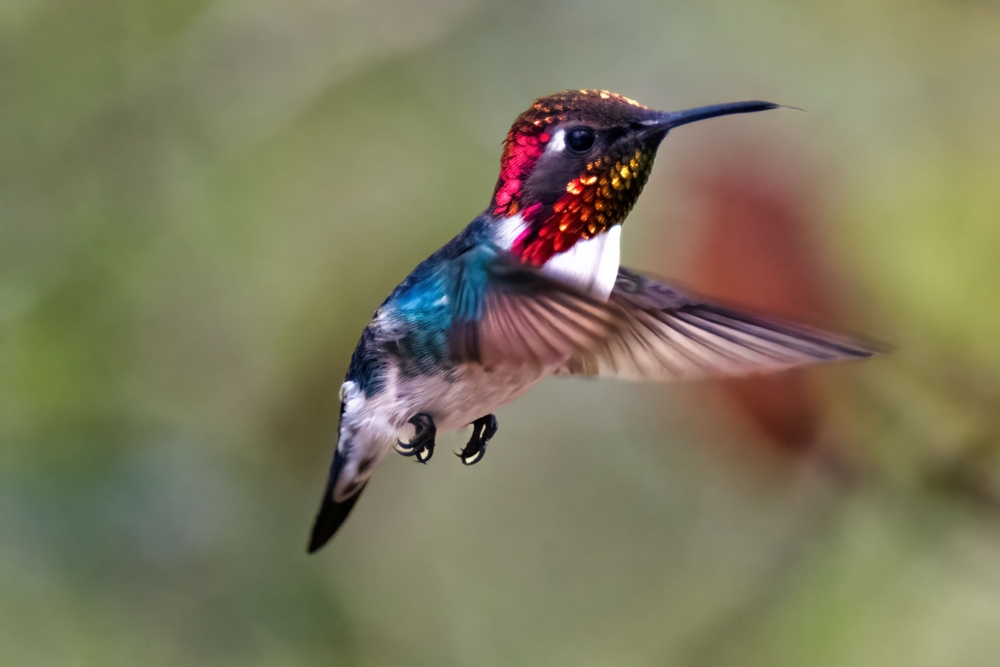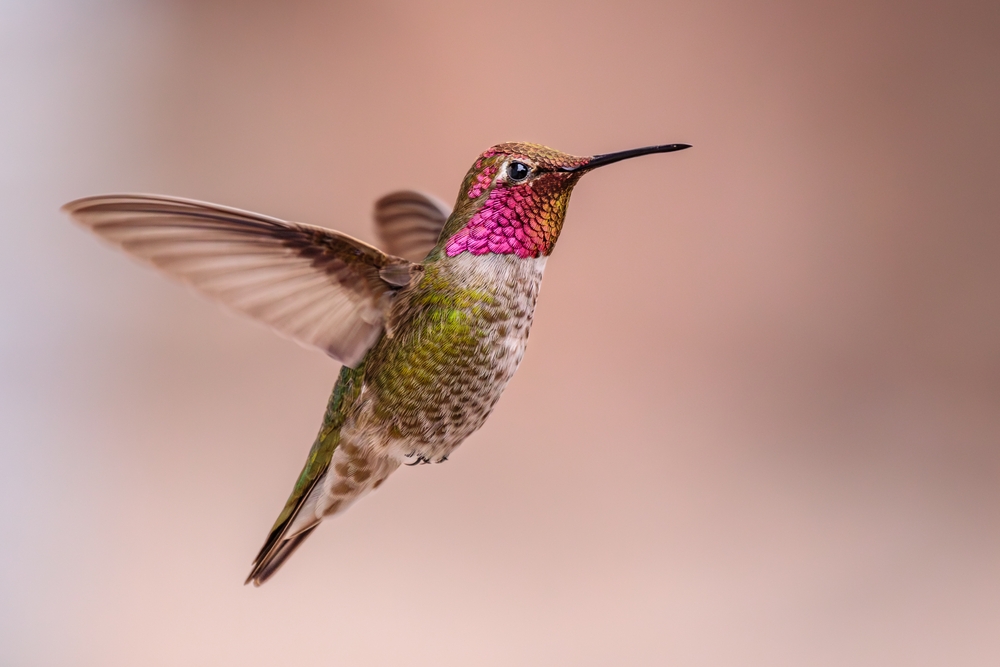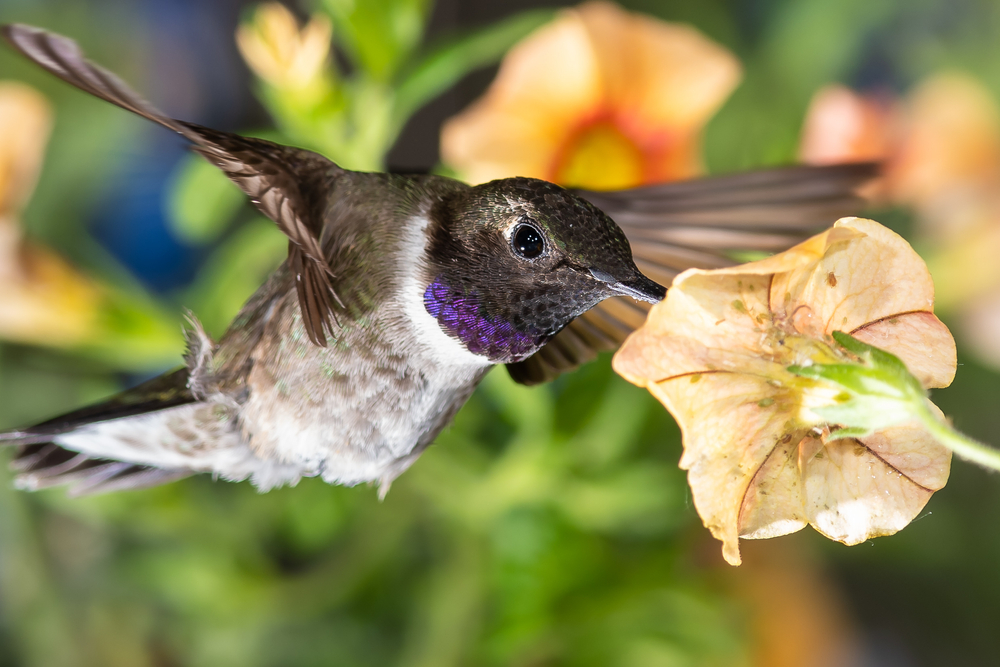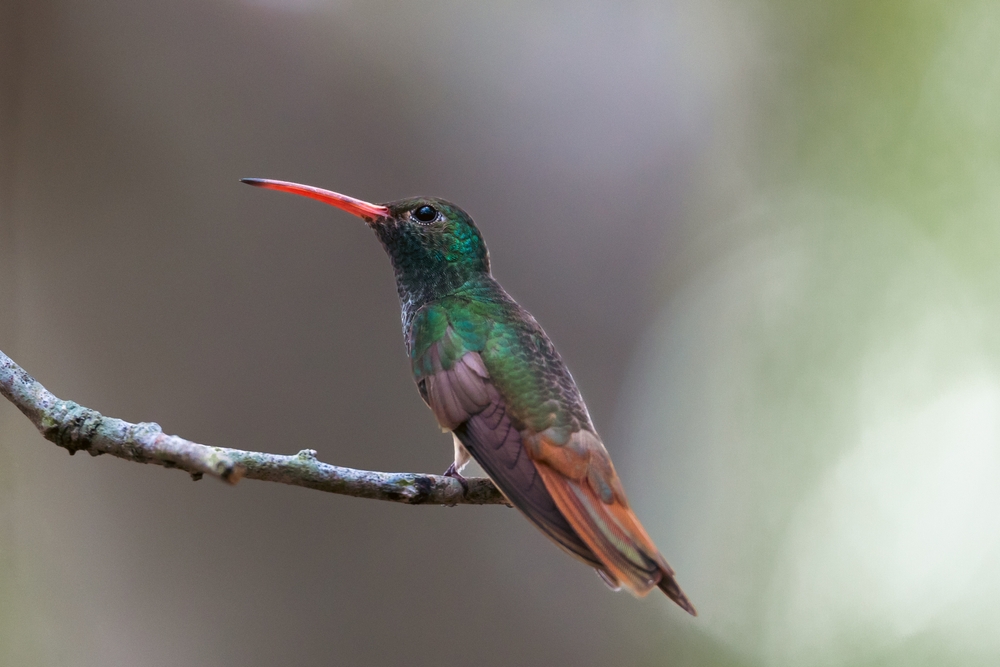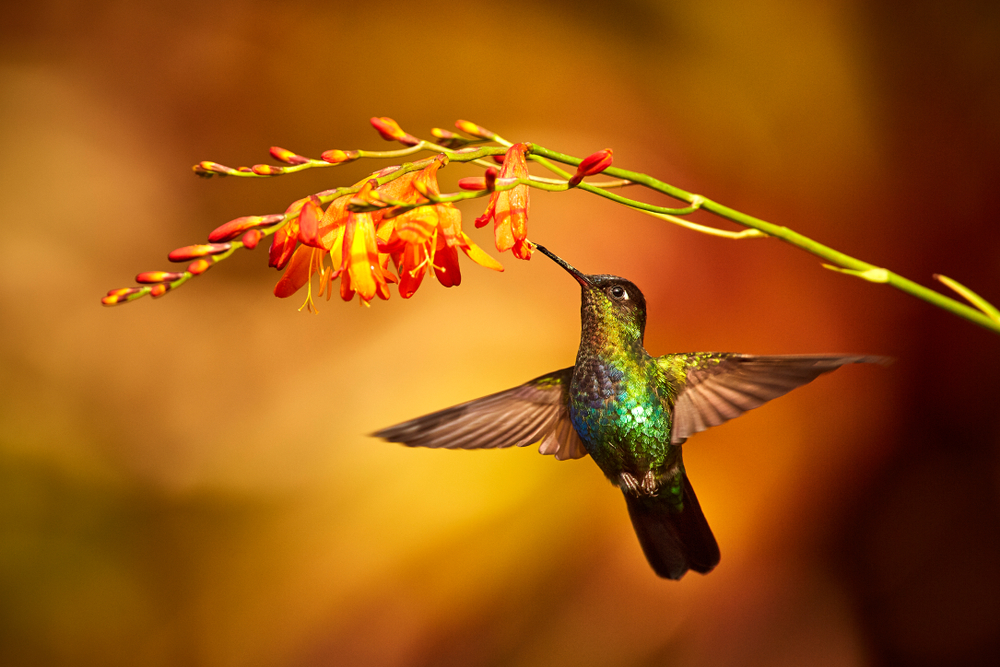The Calliope Hummingbird (Selasphorus calliope) is most closely related to other Selasphorus hummingbirds, especially the Rufous Hummingbird (Selasphorus rufus) and Allen’s Hummingbird (Selasphorus sasin), sharing similar structure and migratory behavior.
About
The Calliope Hummingbird (Selasphorus calliope) is the smallest bird native to the United States and Canada, belonging to the family Trochilidae. Despite its tiny size, this species undertakes one of the longest migrations relative to body length of any bird, traveling thousands of miles each year between its breeding grounds in the western U.S. and Canada and its wintering range in Mexico.
Measuring only 7–9 cm (2.8–3.5 in) in length and weighing a mere 2–3 grams, the Calliope Hummingbird is a marvel of energy and endurance. Males are especially striking, with a vibrant magenta streaked gorget that fans outward like rays when displayed. Females and immatures are more subdued, with greenish upperparts, whitish underparts, and peach-colored flanks. Their small size, rapid wingbeats, and distinctive squeaky calls help distinguish them from other hummingbirds.
The Calliope Hummingbird primarily feeds on nectar from a variety of flowering plants, favoring tubular blooms of meadows, forest edges, and mountain habitats. They also consume insects and spiders, which provide vital protein, especially during breeding season. Males are territorial and perform swooping aerial displays to court females, often flashing their magenta throats in sunlight.
Breeding occurs in the cooler months of spring and summer at elevations up to 11,000 feet (3,350 m). The female alone constructs a delicate nest from plant fibers, moss, and spider silk, typically on evergreen branches. She lays two tiny white eggs and raises the chicks without assistance from the male.
Though small, the Calliope Hummingbird is a resilient traveler, flying across deserts, mountains, and open plains during migration. Populations are currently stable, though habitat loss and climate change may threaten some breeding and stopover sites. Its dazzling plumage, incredible migration, and tiny stature make it one of North America’s most remarkable hummingbirds.
Physical Characteristics
Plumage:
The Calliope Hummingbird (Selasphorus calliope) is the smallest bird in North America, yet striking in appearance.
-
Male: Dazzling with a shimmering magenta gorget, which is unique because the feathers are elongated and spread into streaks or rays down the throat, giving a starburst-like effect. The crown and back are metallic green, while the underparts are whitish with buffy flanks. The tail is dark with a slight fork.
-
Female: Lacks the magenta gorget. Instead, she has a whitish throat sometimes with faint dark spotting, metallic green back, and buffy sides. The tail is tipped with white.
Head:
The male’s elongated gorget feathers flare dramatically when displayed in courtship or defense. The bill is short, straight, and black, suited for feeding on small tubular flowers.
Body:
Tiny and compact, with iridescent green upperparts and a pale underside. Despite its small size, the species is highly territorial and aggressive for its weight.
Size:
-
Length: 2.8–3.5 in (7–9 cm)
-
Wingspan: 4.3 in (11 cm)
-
Weight: 0.07–0.10 oz (2–3 g)
Feet & Tail:
Feet are extremely small and used mostly for perching. The tail is relatively short compared to other hummingbirds, helping with quick hovering and maneuverability.
Flight Style:
Wingbeats average 50–60 per second, producing a faint hum. Males perform dramatic U-shaped courtship dives, accompanied by a buzzing sound produced by their wing feathers.
The Calliope Hummingbird’s combination of minute size, starburst-shaped magenta gorget, and fiery temperamentmakes it one of the most distinctive and remarkable hummingbirds in North America.
Reproduction
Breeding Season:
The Calliope Hummingbird breeds in late spring and summer (generally May through July) across high-elevation meadows and mountain slopes of the western United States and Canada.
Courtship:
-
Males perform U-shaped aerial dives, buzzing past females while flaring their elongated magenta gorget feathers like a radiant starburst.
-
They also hover in front of females, flashing their iridescent throat to reflect sunlight.
-
As with most hummingbirds, males do not assist with nesting or chick-rearing once mating is complete.
Nesting:
-
The female alone builds the nest, usually 1–10 ft (0.3–3 m) above ground on conifers, shrubs, or sometimes on sheltered slopes.
-
The nest is tiny, thimble-sized (about 1 in / 2.5 cm across), built from plant down, moss, and spider silk, camouflaged with lichens.
-
Its elasticity allows it to expand as chicks grow.
Eggs:
-
A clutch typically contains 2 small white eggs, each about the size of a coffee bean (0.5 in / 1.3 cm long).
Incubation:
-
Lasts 15 to 16 days.
-
Only the female incubates.
Chick Development:
-
Chicks hatch altricial (blind, featherless, helpless).
-
The female feeds them regurgitated nectar and tiny insects for protein.
-
Nestlings fledge at about 18 to 21 days, though they may remain dependent for another week while learning to forage.
Maturity:
-
Juveniles quickly gain independence by late summer.
-
Sexual maturity is reached at about 1 year of age, when they are capable of breeding.
The Calliope Hummingbird’s reproduction is remarkable for its minute nests, delicate eggs, and reliance on the female alone, all finely tuned to high mountain habitats.
Lifespan
In the Wild:
Calliope Hummingbirds generally live 3 to 5 years, though many do not survive their first year due to predation, migration challenges, and harsh mountain climates. Adults that establish territories and feeding routes often live longer.
In Captivity:
While rarely kept outside of rehabilitation, individuals may live slightly longer—up to 7 or 8 years—with steady food and protection from predators.
Record Lifespan:
The oldest recorded wild Calliope Hummingbird, confirmed through banding data, lived at least 8 years and 11 months.
Threats to Longevity:
-
Predation: Vulnerable to hawks, falcons, snakes, larger birds, and domestic cats.
-
Migration Hazards: Long-distance migration (from western North America to Mexico) exposes them to storms, exhaustion, and habitat loss at stopovers.
-
Climate Change: Alters the timing of alpine flower blooms, potentially disrupting food supply during breeding.
-
Collisions: Window strikes and entanglement in spider webs or human materials are frequent dangers.
Despite their tiny size, Calliope Hummingbirds are tough survivors, capable of enduring cold mountain nights and migrating thousands of miles, which is extraordinary for the smallest bird in North America.
Eating Habits
Diet:
The Calliope Hummingbird feeds on a combination of nectar and insects, adjusted seasonally to meet its energy needs:
-
Nectar: From alpine and montane wildflowers such as Indian paintbrush, penstemon, columbine, and currant.
-
Insects & Spiders: Tiny flies, gnats, aphids, and spiders, especially important during breeding for protein-rich chick diets.
-
Sap: Occasionally visits sapsucker wells to drink sap and collect insects caught in it.
Foraging Behavior:
-
Uses its short, straight bill and extendable, brush-tipped tongue to lap nectar at rapid speed (10–13 licks per second).
-
Follows a trapline strategy, visiting the same sequence of flowers repeatedly rather than defending large territories like some other hummingbirds.
-
Also hawks insects in midair or gleans them from foliage and spider webs.
-
During migration, will forage in both wild habitats and human-modified areas, including gardens with feeders.
Feeding Adaptations:
-
Wingbeats around 50–60 per second allow them to hover precisely in front of flowers.
-
Can enter torpor on cold mountain nights, slowing their metabolism drastically to conserve energy when food is scarce.
-
Possess an excellent memory for flower locations and nectar renewal timing, helping them maximize efficiency in sparse alpine meadows.
Role in Ecosystem:
As important pollinators of high-elevation wildflowers, Calliope Hummingbirds play a crucial role in alpine ecosystems. By also consuming insects, they contribute to insect population control.
The Calliope Hummingbird’s trapline foraging, cold-climate adaptations, and tiny size make it a specialized and resilient mountain pollinator.
Uniqueness
Smallest Bird in North America:
At just 2.8–3.5 in (7–9 cm) long and weighing 2–3 g, the Calliope is the smallest breeding bird north of Mexico, yet it undertakes long migrations.
Starburst Gorget:
Males display an iridescent magenta gorget with elongated feathers that spread into streaks, forming a starburst-like throat pattern unmatched by any other hummingbird.
High-Altitude Breeder:
This species breeds primarily in alpine meadows and mountain slopes up to 11,000 ft (3,350 m), thriving in habitats where few other hummingbirds nest.
Long Migration for Tiny Size:
Despite being the smallest North American bird, the Calliope Hummingbird migrates thousands of miles annually between western North America and Mexico/Central America, one of the longest migrations relative to body size in the bird world.
Cold-Weather Adaptation:
They can enter torpor on freezing mountain nights, slowing metabolism to survive when food is scarce—an essential trait for life at high elevation.
Trapline Foraging:
Rather than defending large feeding territories, females often follow trapline routes, visiting flowers in a repeated sequence for efficiency.
The Calliope Hummingbird’s tiny size, starburst gorget, mountain lifestyle, and epic migration make it one of the most unique and remarkable hummingbirds in North America.
Be the First to Share Photos of This Species.
FAQ’s
1. What is the closest species to the Calliope Hummingbird?
2. How does the Calliope Hummingbird compare to other hummingbirds?
The Calliope is the smallest hummingbird in North America yet undertakes one of the longest migrations relative to body size. Unlike most, it breeds at very high elevations and can survive freezing nights by entering torpor.
3. What national parks provide the best opportunities to see a Calliope Hummingbird?
They are best observed in western mountain parks such as Yellowstone National Park (Wyoming/Montana/Idaho), Glacier National Park (Montana), and Rocky Mountain National Park (Colorado), where alpine meadows bloom with nectar-rich flowers.



































































